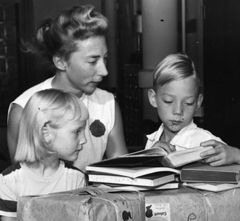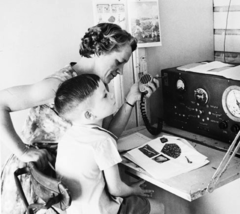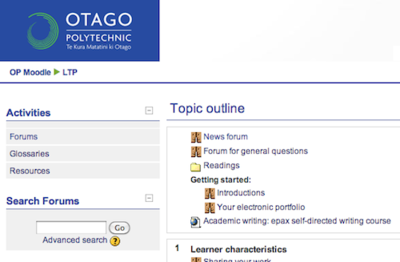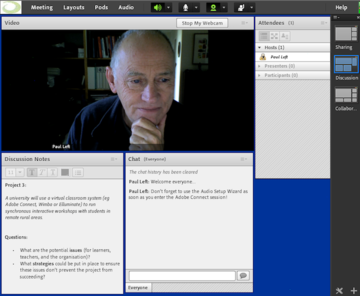Online and distance
| Learning and Teaching in Practice | |
|---|---|
| Module 6: Critique learning design | |
| Learning environments | Introduction | Face to face | Online and distance | Blended learning | Summary |
Distance learning
Distance learning is a term that has been used for learning situations where teachers and learners are not present together in the same physical space.
As media and technologies have evolved in society at large, they have been incorporated into distance learning.
| In its earlier forms, distance education involved a reliance on printed learning materials that were provided to learners.
This model was often called correspondence education as the postal service was used to send the materials to learners and as the primary means of communication between learners and the education provider. The photo, taken around 1950, shows a family checking out their new printed study materials. Typically, the printed study materials would include readings (i.e., content) as well as activities, which often took the form of:
Although we have moved away from a reliance on printed learning materials, this approach of providing content interspersed with learning activities remains widespread in today's distance and online learning. |
| Later, broadcast media such as radio and television were incorporated into distance learning courses, but in general their use has greatly diminished in recent years.
It was common for distance education to be only available to students who could not take part in face-to-face education: for example, children (and sometimes adults) living in remote communities such as sheep stations or lighthouses. The photo, taken around 1960, shows a 'School of the Air' primary student in rural Queensland taking part in a learning activity via two way radio. As we can see from the photo, media such as radio was often used to complement (rather than replace) printed materials. Communication with learners via radio is no longer common in New Zealand and other developed countries: the Internet has become widely accessible and is now the primary means of communication for most distance courses. However, in many developing countries, radio is still a useful technology. |
Online learning
In the 1990s the Internet began to be widely used in distance education as a means of 'delivering' content resources and providing a channel for communicating with learners. The term online learning normally refers to the incorporation of Web-based learning activities and resources, although email often plays an important role as well.
With the wholesale adoption of the World-Wide Web into society and the rapidly-increasing power and sophistication of web-based media and tools, online learning has incorporated a vast array of new technology tools and media. Potentially, online learning means that any student can learn at a distance from the educational institution. However, many distance learning providers also require students to also come on-campus for 'block sessions' or residential classes.
|
Learning Management Systems (LMS) such as Moodle have developed the capability to 'deliver' content in a range of media, as well as providing for various types of learning activities and communication channels. The image of a Moodle course shows how content resources, learning activities and tools for communication (e.g. discussion forums) can be assembled by the designer or teacher into a coherent learning package. Typically, a LMS such as Moodle is focused on asynchronous access, so that learners can participate at a time that suits them. Moodle provides few tools for synchronous communication - that is, where participants take part in 'real time'. Garrison and Anderson (2003, page 26) believe that asynchronous discussion has inherent advantages over face-to-face discussion. They conclude that:
|
|
As well as dedicated systems such as Moodle, other web-based systems can be used as an 'alternative' to a closed LMS - for example, a blog or wiki such as Wikieducator can be used to provide access to resources and tools for discussion. These platforms typically do not provide the full set of LMS features. However, they have the advantage of being more suited to open learning where resources can be accessed without formal enrolment. One of the criticisms of the dedicated Learning Management Systems (such as Moodle) is that they provide a walled garden which shuts off the learning process from the wider world. Models of learning such as connectivism tend to stress the importance of the wider network and global online communities. On the other hand, other educators (especially in the primary and secondary sectors) value the safety of learners provided by the secure environment of the walled garden. |
|
Many education providers have sought to make the online learning environment more closely resemble the face-to-face environment, especially the instant communication and personal presence of teachers and learners. Despite the advantages identified by Garrison and Anderson (see above), such providers have sought to move from asynchronous text-based learning to synchronous learning incorporating audio and/or video communication between teachers and learners. Increasingly powerful personal computers and faster Internet access speeds have enabled the development and use of virtual classrooms, which combine a range of tools for synchronous learning. The image of an Adobe Connect session shows some of the tools available for synchronous communication, sharing content resources. Click on the image to view a larger version. Virtual worlds such as Second Life are also used in education: for example, to simulate a real-world situation, or as an online meeting place. |
|
Check out:
|
References
- Anderson, B., & Simpson, M. (2012). History and heritage in open, flexible, and distance education. Journal of Open, Flexible and Distance Learning, 16(2), 1–10. Retrieved from http://journals.akoaotearoa.ac.nz/index.php/JOFDL/article/viewFile/56/151
- Garrison, D. R., & Anderson, T. (2003). E-learning in the 21st century. Routledge Falmer: London.




